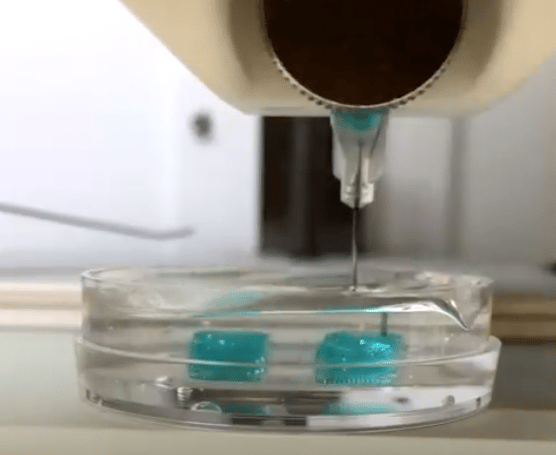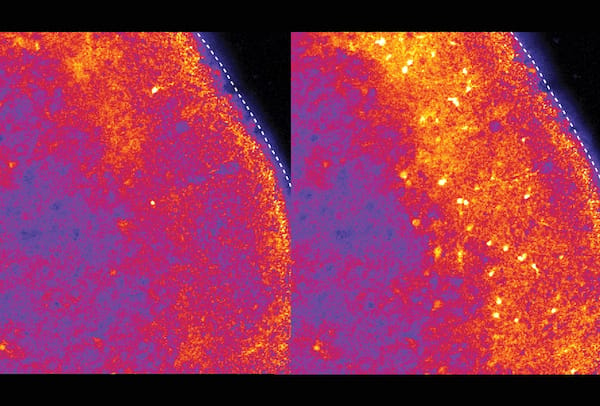Table of Contents
Chair’s corner
Welcome to the summer 2024 edition of the Department of Human Genetics (DOHG) Dispatch. I hope you've had a wonderful summer break and are feeling refreshed and ready for the new academic year. I'm delighted to share some exciting updates with you.

Peng Jin, PhD
First, congratulations to Dr. Emily Allen for another successful NextGen Internship program! This year, our NextGen program welcomed 24 high school students from the Atlanta area for a five-week summer experience. They engaged in classroom learning, shadowed Emory researchers and genetic counselors, went on field trips, and received valuable career and college admissions advice. The interns had the opportunity to hear from various speakers, including professionals in laboratory and hospital roles, a patent lawyer, and a medical science liaison. Highlights included lunches with Dr. Eric Green, Director of the National Human Genome Research Institute, and Dr. Sandra Wong, Dean of the Emory School of Medicine. We are excited to see the future achievements of our NextGen program participants!
I'm also thrilled to welcome several new faculty members to our department: Asheebo Rojas (Instructor, Escayg’s lab), Hailing Shi from Broad/MIT, and Josh Weinstock from Johns Hopkins. Additionally, Jennifer Wong has decided to stay at Emory, accepting a joint tenure-track position in Human Genetics and Pediatrics. Their recruitment will bolster our expertise in computational genomics, spatial genomics, RNA engineering, and epilepsy research. I look forward to watching them develop strong research programs at Emory.
As we look forward to the future, we are reminded of the importance of collaboration, innovation, and education in advancing the field of human genetics. Our department is committed to fostering an environment where students, faculty, and researchers can thrive and make groundbreaking contributions to science and medicine.
Enjoy the rest of your summer!
Peng
People on the move
David Weinshenker was named Director of the Office of Postdoctoral and Mentored Trainee Education, an assistant dean position. He has big shoes to fill; his predecessor Lou Ann Brown did a lot to strengthen postdoctoral stipends and promote the FIRST/IRADCA program. He can draw upon years of experience as a mentor of graduate students and postdocs.

Congratulations to our excellent clinicians: MDs Hong Li, William Wilcox and Rossana Sanchez Russo all named to Atlanta Magazine's Top Docs for 2024 in Clinical Genetics

Diversity, equity and inclusion
Stay tuned for a special edition of DOHG Dispatch on the Next Gen program and its third summer, bigger than ever and with a readjusted lab schedule.
Book club: discussion of Medical Apartheid went well - Suggestions for the fall are welcome; please contact organizer Taylor Pio.
Graduate student Abby Galvez has taken the spot on the Faculty Recruitment subcommittee previously held by Samantha Lanjewar.
Warren Early Career Investigator talks: two scheduled for March 5 + April 30, Sofia Essayan-Perez from Stanford and Kellie Willford from Duke
Department spotlights
Lauren Lichten

I’ve been a genetic counselor for 19 years and worked in genetic counseling education for more than ten years. 2019, I moved from Boston to Atlanta to be the Assistant Program Director of the Emory GC Training Program. The last five years at Emory have flown by, especially the last year as I transitioned to the role of program director. Outside of the program, I also provide genetic counseling services in the Emory ALS Center.
Educational background: BA in Molecular Biology from Colgate University, MS in Genetic Counseling from Brandeis University.
Hobbies/outside interests: Cuddling on the couch with my dog Genie (the pillow version pictured here – a gift from the class of 2023), Orange Theory exercise classes, reading in comfortable chairs, and exploring local festivals, restaurants, and breweries.
Tamika Malone
Tamika has dedicated herself to caring for animals in various roles. In 1996, she interned at Zoo Atlanta as a large mammal keeper, volunteered at several Georgia Wildlife Rescue shelters, and worked as an emergency room veterinary technician at Pets are People Too. She continued her animal care journey by joining Emory's DAR before taking a position with Dr. Stephen Warren's lab in 1998 as a Rodent Colony manager.

During COVID, she volunteered for a non-profit trap-neuter-return (TNR) program for Gwinnett County. In her free time, she attends evening classes at Goizueta Business School, working towards a Master's in Business Administration focusing on the healthcare industry. With a Bachelor of Science degree from Spelman College and nearly 25 years of experience in the Department of Human Genetics (DOHG), it is a natural progression.
Emily Hill

Emily is originally from the lovely state of Michigan, where she grew up and later attended the University of Michigan for her undergraduate studies (Go Blue!). Currently, she is a Genetics and Molecular Biology graduate student in Steven Sloan's lab. Her thesis work centers on understanding the molecular mechanisms underlying the formation and maintenance of reactive astrocytes in the brain in response to disease and injury.
When Emily isn't in the lab, she is likely pursuing one of her many hobbies that have given her carpal tunnel, such as crocheting, playing video games, or rock climbing, or trying to rest her wrists by gardening, watching Michigan sports, or curling up with a good book and her beloved cat, Hutch.
New publications
SCN8A-derived epilepsy: beyond the usual suspects
Frontiers in Pharmacology, June 3, 2024
From Jennifer Wong, PhD and Andrew Escayg, PhD
Carvedilol increases seizure resistance in a mouse model of SCN8A-derived epilepsy
SCN8A encodes a voltage-gated sodium channel, and mutations altering its function result in epilepsy. In this paper, Wong and Escayg sort through several proposed medications for SCN8A-derived epilepsy, beyond known sodium channel blockers (the usual suspects) such as carbamazepine or lamotrigine. The medications tested arose through an in vitro screen or clinical experience: amitriptyline, carvedilol, nilvadipine and fenfluramine. The medications were tested in WT and SCN8A R1620L mice, in seizures driven by electrical current or a pro-convulsant drug.

Carvedilol, a beta-blocker usually prescribed for heart failure
Only carvedilol was able to increase seizure resistance in the SCN8A R1620L mice. The results provide support for additional investigation of this class of medications in SCN8A-derived epilepsy; currently two novel sodium channel blockers are being tested in clinical trials.
Survey of women with PKU re health management issues
From Rani Singh, PhD, RD, LD - First author RSPH student Abigail Aronoff
Molecular Genetics and Metabolism Reports, May 24, 2024
Assessing the lived experiences of females with phenylketonuria in their health management
This survey provides a broad look at issues faced by people with PKU. Women with phenylketonuria (PKU) were recruited from Emory Metabolic Camp or the Medical Nutrition Therapy for Prevention program. Interviews focused on dietary management, reproductive health care and interpersonal issues.

2023 Emory Metabolic Camp
Concerns about pregnancy and problems with insurance coverage were common. While most had a positive attitude toward health management, about half said they had been bullied during childhood because of their dietary requirements. Two respondents’ dietitians had previously threatened to drop them when they were noncompliant, and both stated that this “tough love” pushed them to get on track. Bonus: the paper’s appendix includes interesting quotes from respondents.
Pregnancy outcomes from women with PKU
Molecular Genetics and Metabolism Reports, May 18, 2024
From Rani Singh, PhD, RD, LD — Aileen Kenneson-Adams as first author.
Characteristics and outcomes of pregnancies among women with phenylketonuria from the NBS Connect registry
Women with phenylketonuria who have high phenylalanine levels during pregnancy have an increased risk of complications, known as maternal PKU syndrome. The authors use Newborn Screening Connect, a web-based self-report patient registry in existence from 2012 to 2019, to gather information on 17 pregnancies. Note: these pregnancies were largely undertaken before the 2018 approval of the PKU enzyme replacement therapy Palynziq.

High Phe levels during pregnancy increase the risk of maternal PKU syndrome
Miscarriages or terminations were reported in three of the seventeen pregnancies for which data were available. Six out of fourteen babies born to women with PKU demonstrated symptoms of maternal PKU syndrome. Several women reported maternal PKU syndrome symptoms in their offspring despite having phenylalanine in the recommended range prior to pregnancy. The results suggest that women with PKU continue to struggle with access to components of medical nutrition therapy, and that patient registries can be a valuable source of information about patient experiences.
Mini-brains get vascularized
From Steven Sloan, PhD — first author BME graduate student Melissa Cadena
Advanced Healthcare Materials, May 30, 2024
A 3D Bioprinted Cortical Organoid Platform for Modeling Human Brain Development
The Sloan lab collaborated with Vahid Serpooshan’s lab in Biomedical Engineering to develop a platform for co-culturing brain organoids and vascular cells, providing “a new toolbox to create more complex and physiologically relevant models of human brain development and function.”
The authors employed 3D bioprinting embedded within a support hydrogel; gelatin methacrylate bioink was fabricated in-house. They demonstrated that endothelial cells in printed channel structures can migrate towards and infiltrate into the embedded organoids.

Screenshot from video of 3D printing process, courtesy of Melissa Cadena
The authors note several opportunities for future customization, such as replacing the UV crosslinking used to seal the organoids in scaffolds with visible light, and using brain-appropriate sources for extracellular matrix and endothelial cells.
Acoustic startle in 22q11 deletion syndrome
From Joseph Cubells, PhD and colleagues
Schizophrenia Research, May 3, 2024
Reduced amplitude and slowed latency of the acoustic startle response in adolescents and adults with 22q11.2 deletion syndrome
This was the first study measuring acoustic startle latency in adolescents and adults with 22q11 deletion syndrome, which contributes high risk for schizophrenia. Postdoc David Parker was first author, working with Cubells and Emory schizophrenia veterans Elaine Walker and Erica Duncan.
This group is engaged in a “deep phenotyping” project of 22q11 deletion syndrome. In their NIMH grant application, the authors propose that acoustic startle latency may predict severity of prodromal symptoms and risk of conversion to schizophrenia. Acoustic startle latency was known to be prolonged in people with schizophrenia. The authors report they were unable to study prepulse inhibition, another aspect of sensorimotor function altered in schizophrenia, because of the high number of “non-startlers” in the 22q11 group. Future directions for this work include investigating abnormalities in neurotransmission from 22q11 stem cell-derived neurons.

From Parker et al (2024) - The 22q11 group had “very robustly reduced” startle magnitude and prolonged acoustic startle latency.
ASOs for Timothy syndrome
Nature, April 24, 2024
From Fikri Birey, PhD — from Pasca lab at Stanford, with Xiaoyu Chen as co-first author
Antisense oligonucleotide therapeutic approach for Timothy syndrome
Timothy syndrome arises from a missense variant in exon 8A of the gene CACNA1C, encoding a calcium channel, and is characterized by heart problems, seizures and autism. The Timothy syndrome variant leads to increased inclusion of the splice form containing exon 8A, and splicing of CACNA1C is developmentally regulated, with a shift from exon 8A to 8 during early development. This led to an approach seeking to inhibit inclusion of exon 8A with antisense oligonucleotides (ASOs), similar to the FDA-approved strategy for Duchenne muscular dystrophy.

Antisense oligonucleotides restored calcium entry (right) in patient-derived neurons transplanted into rat brain
ASOs can rescue Timothy syndrome-related problems of splicing, electrophysiology, and dendrite morphology in patient-derived cortical brain organoids — both in culture and transplanted into the somatosensory cortex of newborn athymic rats. The ASOs are injected intrathecally. There are several limitations: the ASOs affect both the WT and Timothy syndrome alleles, some patients have the same mutation but in exon 8 instead, and cardiac function was not assessed.
Analogous ASO approaches are also being tested for Dravet syndrome and Angelman syndrome in clinical trials. According to a Stanford press release, a clinical trial for Timothy syndrome is being planned.
Very Early Levodopa May Prevent Self-Injury in Lesch-Nyhan Disease
Pediatric Neurology, March 26, 2024
From Hyder Jinnah, MD, PhD
In this case report, Jinnah and colleagues in the Netherlands and Israel provide long-term outcomes for three people with Lesch-Nyhan disease treated with levodopa starting in infancy. This is a significant finding for the families of children diagnosed with this rare disorder, suggesting that “levodopa, given early enough and sufficiently dosed, might be able to prevent self-injury in LND.”
Lesch-Nyhan disease arises from a deficiency in the HPRT enzyme, part of purine salvage metabolism. How HPRT deficiency leads to symptoms such as dystonia and self-injurious behavior is thought to involve a deficit in the development of dopamine neurons. Clinical experience with Parkinson’s prompted the potential remedy of levodopa, a precursor of dopamine.
Although previous studies of levodopa in Lesch-Nyhan were disappointing, the rationale here was that previous studies didn’t start early enough, because the age when dopamine neuron dysfunction occurs may influence the neurological outcome. Finding patients and starting therapy early enough was difficult, Jinnah says. The paper reports that self-injury was prevented in two patients, now teenagers. A third displayed self-injury, but was on a lower dose.
Intrathecal Vector Delivery in Juvenile Rats via Lumbar Cistern Injection
From Judy Fridovich-Keil, PhD
Journal of Visualized Experiments, March 29, 2024
This paper, a collaboration between Fridovich-Keil and Anthony Dosante in Neurosurgery, describes an approach for gene therapy vector delivery to the central nervous system in rats. This is basically a “spinal tap” (AKA lumbar puncture), in which the gene therapy vector is introduced into the cerebrospinal fluid. Fridovich-Keil is planning to use this technique to test gene therapy in a rat model of galactosemia.
Epigenetic modifications of DNA and RNA in Alzheimer’s disease
From Bing Yao, PhD and Peng Jin, PhD
Frontiers in Molecular Neuroscience, April 25, 2024
This review is notable partly because of first author Paula Martinez-Feduchi, lab manager in Bing Yao’s lab. She is moving to Seattle to start graduate studies in Molecular Medicine + Mechanisms of Disease. Congratulations Paula!
The review covers DNA cytosine and adenine methylation, RNA adenine methylation, tRNA modifications and the variety of big and small RNA species.

Paula Martinez-Feduchi
Identifying latent genetic interactions in biobank data
From Michael Epstein, PhD
Genome Medicine, April 25, 2024
Identifying latent genetic interactions in genome-wide association studies using multiple traits
What accounts for “missing” heritability in complex traits or diseases? The authors describe Latent Interaction Testing, a kernel-based method for mapping genetic variants with interaction effects on multiple phenotypes. (Kernel is a math/machine learning term describing measurement of the similarity between two sets of variables, with applications across many fields.) They then apply the technique to obesity-related traits in the UK Biobank and detect variants with interactive effects near known obesity-related genes.

Postdoc Andrew Bass was first author, and is currently at Cambridge University in the UK.
Stretching wide for trans TWAS effects in breast/ovarian cancer
From Michael Epstein, PhD — former gradudate student Taylor Head as first author
Cis- and trans-eQTL TWASs of breast and ovarian cancer identify more than 100 susceptibility genes in the BCAC and OCAC consortia
American Journal of Human Genetics, May 8, 2024
The team performed TWAS (transcriptome-wide association study) of breast/ovarian cancer subtypes incorporating trans-eQTL effects, which aided in identifying new breast/ovarian cancer susceptibility genes. The authors used a Bayesian genome-wide approach that considers cis and trans effects of regulatory loci. A total of 101 genes significantly associated with risk for breast cancer phenotypes and 8 with ovarian phenotype.

Taylor Head, PhD, now a postdoc at MD Anderson
Bayesian genome-wide TWAS applied to AD
Alzheimer’s Research & Therapy, June 1, 2024
From Jingjing Yang, PhD - First author Shuyi Guo recently started his biostatistics PhD at University of Texas Health Science Center in Houston.
Bayesian genome-wide TWAS with reference transcriptomic data of brain and blood tissues identified 141 risk genes for Alzheimer's disease dementia
Transcriptome-wide association studies (TWAS) can identify genes associated with complex diseases. But most TWAS of Alzheimer’s disease have been limited to examining trait loci proximal to the test gene. This paper details their use of a Bayesian genome-wide TWAS to take in more information. The authors identified 46 risk genes that had not been reported as associated with Alzheimer’s, but were connected with known AD risk genes by protein-protein interactions.
Brief mentions (collaborations)
Beyond memory impairment: the complex phenotypic landscape of Alzheimer's disease — Wingos are co-authors on a Mt Sinai review in Trends in Molecular Medicine
Familial aggregation of seizure outcomes in four familial epilepsy cohorts, Epilepsia, Michael Epstein part of EPGP/Epi4K Consortium study
Investigating gene functions and single-cell expression profiles of de novo variants in orofacial clefts, Human Genetics and Genomics Advances, Elizabeth Leslie part of University of Texas Health Science Ctr Houston study
An isoform quantitative trait locus in SBNO2 links genetic susceptibility to Crohn's disease with defective antimicrobial activity, Nature Communications — Subra Kugathasan part of Oxford study
Longitudinal plasma metabolome patterns and relation to kidney function and proteinuria in pediatric chronic kidney disease, Clinical Journal of the American Society of Nephrology, Jian Hu part of CKD Biomarkers Consortium
The association between neighborhood deprivation and DNA methylation in an autopsy cohort, Aging,Thomas Wingo — This study identified one CpG site (cg26514961, PLXNC1 gene) that was significantly associated with neighborhood deprivation in brain tissue.
Association between Fine Particulate Matter Exposure and Cerebrospinal Fluid Biomarkers of Alzheimer's Disease among a Cognitively Healthy Population-Based Cohort, Environmental Health Perspectives, Thomas Wingo – draws upon Emory Healthy Brain Study data
Epistatic Features and Machine Learning Improve Alzheimer's Disease Risk Prediction Over Polygenic Risk Scores, Journal of Alzheimer’s Disease, Thomas Wingo, part of AD Neuroimaging Initiative project
Sex differences in dystonia, Movement Disorders Clinical Practice — Jinnah and colleagues analyzed patient information from the Dystonia Coalition database and the MDSGene database, containing predominantly early-onset monogenic dystonias. More than 4500 individuals studied.
Newly funded research
Tambourine Philanthropies/Milken Institute, Jimena Andersen, $600,000 until 12/31/2025: Understanding ALS mechanisms in a novel human cellular model of the cortico-motor pathway
This grant is funded by Tambourine and administered by Milken. Tambourine is a private foundation started by billionaire Ben Silbermann, co-founder of Pinterest, and his wife Divya Silbermann.
The first RFP for Tambourine’s ALS Breakthrough Research Fund received 143 applications, with 8 proposals ultimately selected for funding. Andersen’s project aims to develop models that recapitulate the connection between the brain, spinal cord, and muscles using patient-derived cells. Her team will use these novel models of ALS to compare the cellular composition, gene expression profiles, and genetic susceptibility of ALS-affected and unaffected cellular networks.
F32, Tiffany Terry, NIDDK, The Critical Role of Ciliary ARL13B in Controlling Energy Homeostasis
The Caspary lab has created a mutant mouse in which the ARL13B protein, a regulatory GTPase and guanine nucleotide exchange factor, is excluded from cilia but retains all its known functions. The mice are hyperphagic and obese and display defects in glucose and insulin metabolism.
Previously known mutations in ARL13B cause Joubert syndrome -- but not obesity. A key question for the planned project: in what cell types does ARL13B function to regulate energy homeostasis?
R03, Jennifer Wong, NIA, Targeting excitability in Alzheimer’s disease
AD patients have an increased risk of developing epilepsy, and over 40% without a history of epilepsy exhibit subclinical epileptiform activity. Increased expression of the voltage-gated sodium channel SCN8A has been observed in brains from AD patients and mouse models of AD.
A group from Dalian Medical University reported in 2022 that hippocampal knockdown of SCN8A expression in AD model mice resulted in reduced amyloid plaques and amelioration of cognitive and synaptic deficits. Wong and colleagues will expand on this work, proposing to target SCN8A in the locus coeruleus (important starting place for AD pathology) and possibly prevent or delay LC hyperexcitability.
Medical genetics
Congratulations to genetic counseling student Emily Peery, one of four Randi J. Hagerman Summer Scholars studying Fragile X syndrome supported by National Fragile X Foundation. Project title: Women’s Healthcare Provider Knowledge on FXPOI: Improving Understanding Through an Educational Tool
Advancing equity in CF newborn screening
A recent New York Times article explains how cystic fibrosis diagnosis can be delayed for families of color. The persistent perception that cystic fibrosis only affects white people lies behind a deficit in tracking CFTR variants.

Rena Barrow-Wells’s son Jahsir was eventually diagnosed with cystic fibrosis
The mother whose family’s story is highlighted, Rena Barrow-Wells, lives in Georgia. She has been working with state officials to expand Georgia’s newborn screening program for cystic fibrosis so that more variants are included. The number of variants screened was increased from 39 to 139 (on par with several other states) this spring, Dr Li reports.
Genetic counselor Eileen Barr and medical geneticist Rosanna Sanchez Russo are co-authors on a manuscript now in preparation, with senior author Rachel Linneman, director of CHOA’s Cystic Fibrosis Center. The report includes data on CFTR variant frequencies and screening in Georgia’s diverse population. Their research was supported by the Cystic Fibrosis Foundation.
Metabolic camp
Every June, Emory Human Genetics hosts a camp for young women with PKU (phenylketonuria) or MSUD (maple syrup urine disease), who have to limit their intake of naturally occurring protein to stay healthy. The camp focuses on nutrition, genetics and reproductive health classes, paired with cooking workshops, wellness and other fun activities. Researchers also tested new technologies that could improve campers' lives, such as a convenient blood sample analyzer, which can provide point-of-care Phe measurements. Read the Emory News story.

Chef Kristin Narlow in action at Metabolic Camp 2024
First in-person CRD conference
The Emory CRD (CTCF-Related Diseases) Center's first in-person conference was attended by families whose children have been affected by the rare genetic condition, as well as Emory researchers and clinical experts. We had a special edition of DOHG Dispatch on it, with more photos from the event.

